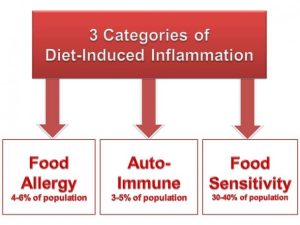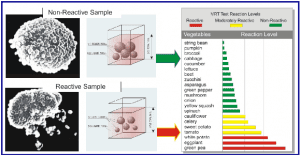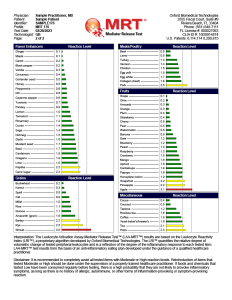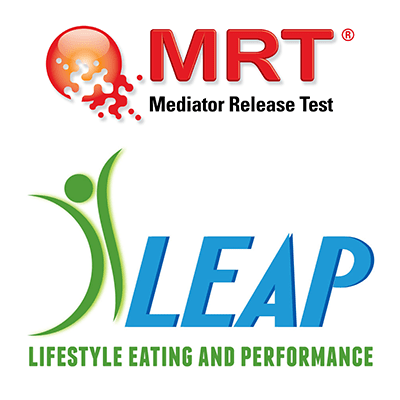Food Sensitivities
 An Under-Diagnosed Source of Inflammation & Symptoms.
An Under-Diagnosed Source of Inflammation & Symptoms.
Food-induced inflammation is so relevant to the health of so many patients, that its importance cannot be overstated. Food sensitivities represent an important source of inflammation in chronic inflammatory conditions such as:
- Irritable bowel
- Migraine
- Fibromyalgia
- Attention deficit
- Hyperactivity
- Obesity
- Many other challenging conditions
- Wellness
Fully addressing sensitivities can produce a major improvement in outcomes, especially in your treatment-resistant patients.
MRT®: The Best Way to Identify Hidden Inflammatory Foods
Food sensitivity reactions may be delayed by hours or even days after ingestion.
Food sensitivities are dose-related. This means a small or moderate amount of a reactive food may not cause any noticeable symptoms, but a larger amount does. Or perhaps when you eat 2-3 moderately reactive foods at the same time, you get symptoms. But if you ate only 1 of those foods you would not.
Why MRT® is the Gold Standard for Food Sensitivity Testing:
MRT® is a functional “endpoint” test, meaning it measures and quantifies the endpoint of all inflammation generating sensitivity pathways – mediator release from white blood cells.
Aside from the fact that most food sensitivity blood tests have very limited clinical value, thus eating plans based upon them will also have limited clinical value, for the vast majority of patients, ROTATION DIETS ARE VERY DIFFICULT TO FOLLOW. Therefore, patient compliance is typically poor, and outcomes are less than optimal. Rotation diets, though effective, are not the best way to maximize outcomes. So what is The LEAP eating plan?
About Diet-Induced Inflammation
Understanding Diet-Induced Inflammation
There are 3 categories of diet-induced inflammatory reactions: allergy, autoimmune disease, and sensitivities. Of the 3, sensitivities are the most prevalent.
Food and food-chemical sensitivities are a highly complex category of non-allergic (non-IgE), non-celiac inflammatory reactions. They involve multiple mechanisms and may be governed by either innate or adaptive immune pathways. They’re one of the most important sources of inflammation and symptoms across a wide range of chronic inflammatory conditions. They are also one of the most clinically challenging.
Due to their inherent clinical and immunologic complexities, as well as a lack of general knowledge within conventional medicine of their role as a source of inflammation in IBS, migraine, fibromyalgia, arthritis, GERD, obesity, metabolic syndrome, ADD/ADHD, autism, etc., food and food-chemical sensitivities remain one of the most under-addressed areas of conventional medicine.
Clinical Complexities
Food and food-chemical sensitivities have clinical characteristics that make it very challenging to identify trigger foods. For example, symptom manifestation may be delayed by many hours after ingestion; reactions may be dose-dependent; because of a breakdown of oral tolerance mechanisms, there are often many reactive foods and food chemicals; even so-called anti-inflammatory foods, such as salmon, parsley, turmeric, ginger, blueberry, and any “healthy” food can be reactive.
Medical Conditions Where Sensitivities Can Play a Primary or Secondary Role Gastrointestinal
Immunologic Complexities
Recent research into adverse reactions to gluten has uncovered a new form of diet-induced inflammation termed “non-celiac gluten sensitivity” (GS). Gluten sensitivity is 6-8 times more prevalent than celiac disease, can provoke a wide range of clinical symptoms, and has been proven to activate the innate immune system, a branch of the immune system that has been almost completely neglected for years by researchers as a source of diet-induced inflammation and symptoms. But gluten is just one potential piece of the puzzle. As stated previously, any food can trigger an inflammatory response, even so-called anti-inflammatory foods. The key is to know which specific foods and food chemicals are triggering reactions in each specific patient. That’s the beginning of the best way to design an eating plan that will produce the maximum clinical benefit.
Common feature of Diet-induced Inflammation
The single common feature of all diet-induced inflammatory reactions is that they ultimately cause mediator release (cytokines, leukotrienes, prostaglandins, etc.) from various white blood cells (neutrophils, monocytes, eosinophils, lymphocytes). This is true whether reactions are immediate or delayed, whether dose-dependent or not, whether governed by the innate or adaptive immune systems, whether cell-mediated or humoral-mediated, and whether inflammation remains at a sub-clinical level or becomes clinically symptom-provoking. All food-induced inflammatory reactions involve mediator release, which is the single most important event leading to all the negative effects your patients suffer, including symptom generation.


LEAP Anti-Inflammatory Eating Plan
LEAP is so much more than just a computer generated rotation diet based on the results of a blood test. It is a complete system of developing a healthy, anti-inflammatory eating plan for each patient.
- LEAP maximizes the value of the information MRT® provides
- Incorporates the patient’s history
- Includes the patient’s food preferences
- Is easier to follow
- And gets greater patient buy-in and adherence and consistently produces the best outcomes in the shortest time
LEAP dietary care provides the opportunity to get the maximum benefit from your testing. If you want the best, you can have it with LEAP. LEAP has helped thousands of patients across the country turn years of suffering into a bright, happy, healthy future, free of the symptoms that once seemed an inescapable part of life. Even world-class athletes have used LEAP to help them be their absolute best.
The Testing Process
- We will chat before or during our first consultation to make sure MRT Is a good fit for you based on your unique clinical picture and nutrition/health goals.
- Once you have completed your purchase and appointment scheduling online you will be emailed a receipt which will contain links to several PDF forms. The forms include a requisition form and health assessment forms to be completed and returned to me.
- You’ll receive a MRT test kit in the mail, delivered to your address on file with me.
- The next step is to book a blood draw with a local lab in network with Oxford Biomedical Technologies (the company through which you’ll receive the Mediator Release test kit and results booklet).
Make sure to bring the requisition form and MRT test kit to your appointment!
Once your blood draw is all set, and the samples have been submitted, the level of reactivity (degree of mediator release) occurring within your white blood cells from the sample collections will be measured against a control as well as 176 different foods and chemicals.
Within a week to 10 days your blood draw, I’ll receive a secure PDF with your results. You’ll also receive a hard copy of your results with a booklet for you to refer to so you can learn more about how to navigate food sensitivities and possible dietary restrictions through restaurant planning and recipe modification.
Where to Get Labs Drawn
TRAVALAB
MOBILE BLOOD DRAW
DRAW SITE
Sample Test
What results will I see?
MRT is the most accurate (sensitivity 94.5% & specificity 91.7%) and the most comprehensive test available for determining food sensitivities and has helped thousands of people identify their triggers and put an end to their suffering.
 Research has shown that patients with irritable bowel syndrome (IBS), migraine headaches, fibromyalgia, chronic depression, and many other conditions have higher than normal levels of these mediators circulating throughout their bodies. For many, the “trigger” that causes the mediators to be released can be linked to foods or chemicals in their diet.
Research has shown that patients with irritable bowel syndrome (IBS), migraine headaches, fibromyalgia, chronic depression, and many other conditions have higher than normal levels of these mediators circulating throughout their bodies. For many, the “trigger” that causes the mediators to be released can be linked to foods or chemicals in their diet.
 Irritable Bowel Syndrome:
Irritable Bowel Syndrome:
Migraine:
Urticaria/Hives:
Eczema:
ADD/ADHD:
GERD:
Chronic Fatigue:Inflammatory Arthritis:
Fibromyalgia:
View sample test here






